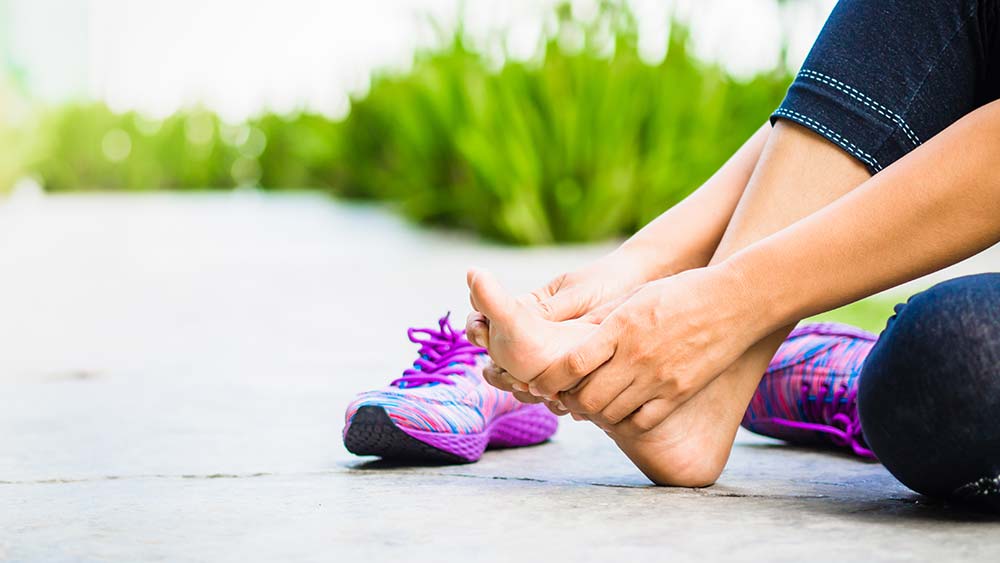
Feet are much more than a physical foundation — they significantly govern fitness, movement and quality of life. Unfit feet can cause stress throughout the body, waste energy and even contribute to emotional stress.
Feet-speak: It’s a body language most of us know. From discomfort and pain, to toe deformities and joint dysfunction; from flat feet, corns, and calluses, to problems with skin and nails, these and other visual and sensory information symptomatic of stress cause our feet to cry out to our brains for help.
Foot pain is very common. Studies show that up to 36 percent of people complain of pain and other discomfort in the feet. Many more realize that removing their shoes at the end of the day makes them, and their feet, happier — meaning the feet were compressed and stressed much of the day. Moreover, clinical evaluations, from those who are inactive to athletes, uncover some type of foot dysfunction in 80 percent of individuals.
Active feet
For active people and athletes, foot function is of even more particular importance. While the energy we use for walking, running, and exercise competition comes from both glucose and fat, our feet provide another source: They house a unique energy-return system. This incorporates many foot, ankle and lower leg structures that harness the gravitational impact forces from the feet hitting the ground — and it’s a significant source of additional energy. Dysfunction of the feet and their associated muscles, tendons and bones — causing muscle imbalance, overstretched tendons, inflexibility — renders this energy lost.
Foot dysfunction is an independent risk factor for movement disorders, which promote impaired balance, poor posture and irregular gait throughout the body. This increases the risk of falls, the loss of independence in aging, and reduces quality of life at any age. In addition, foot problems, which come in all shapes and sizes, are a source of significant healthcare expenditure.
Can you easily stand on one foot? And the other? And with flat properly fitting shoes on? If not, there may be ongoing mechanical stress in the feet.
Inflammation
In addition to physical stress, foot dysfunction can have significant biochemical connections. The most common may be acute or chronic inflammation, which can occur in joints, tendons and muscles. This may be due to the micro-trauma from wearing bad shoes, a sudden injury like a twisted ankle, or developing tendinitis or a painful joint.
Chronic inflammation is significantly influenced by bad foods we eat or healthy fats we avoid, and the amount of stored body fat. So food choices can influence foot function significantly, a key reason why those with chronic disease such as diabetes and a poor cardiovascular health often have foot problems too.
Inflammation can also promote pain, which can contribute to mental-emotional stress as well.
Whether from trauma, illness or neglect, most foot problems are preventable. And, most can be resolved with conservative care by the individual or from an appropriate healthcare practitioner. For example, just switching to properly fitted shoes can improve some foot problems.
Foot language
The feet speak at any time, from the middle of the night to those first morning steps, right through when removing shoes at day’s end. It can be localized, like in an area of a joint or the heel, or the whole foot that’s throbbing, hot, or achy all over.
Much of what the feet tell us is in a form of sensory-speak, with a wide range of feelings from great and pleasurable (like when we are having a foot rub) to stiff, tight, or achy, and pain. Unfortunately, too many people ignore the feet, or have gotten too used to hearing them complain.
Unfortunately, sometimes the feet don’t speak, even when there’s a problem. Asymptomatic muscle imbalance, for example, is a common and overlooked condition that can contribute to many of the conditions noted above. In particular, muscles are meant to maintain the foot’s three arches, along with supporting the 26 bones, 30 joints and more than 100 muscles, tendons and ligaments.
Acute foot stress from shoes can trigger muscle imbalance and improper movement, causing discomfort with resulting pain. Chronically these same problems can contribute to more serious impairment in the joints, such as osteoarthritis, or bones, where various types of fractures can occur.
The many muscles controlling all parts of the feet are as vital as properly aligned tires and good tread for autos. Much of the foot and ankle support comes from muscles that attach above in the leg. So calf or shin pain is often associated with foot dysfunction, which in turn can affect the knee.
Feet also speak visually. Look for signs that indicate excess uncompensated wear and tear, from excess callouses and corns, to damaged nails, hammertoes and bunions.
Shoe issues
The two most common physical problems associated with wear and tear in the feet include:
Bad shoes, a primary reason we beat up our feet. It’s not just thick, over-supported sports shoes, but dress types too, even slippers and sandals. While we think of high heels as the main culprit, when shoes are made for style instead of function, our feet cry foul.
Poor fitting shoes are just as common. Finding the right fit for your particular feet is essential.
Both of these problems can traumatize not just the feet, but the entire body — just watch someone’s gait while walking in a pair of bad shoes.
Your aching feet
Local foot injuries are common too, often from overuse. Combining overtraining, for example, with bad running shoes, is a recipe for foot troubles.
Foot and calf muscle cramping is common too, a sign that something is wrong. There are no cookbook causes or remedies for cramps, other than they are not normal — so some aspect of health and/or fitness is not right.
As the years pass, more foot problems develop due to poor health, especially from poor circulation and blood sugar, and reduced immunity. These conditions can cause numbness, tingling and pain in the feet.
Foot sense
Even before our feet are capable of supporting the whole body by standing, our young feet possess powerful sensory mechanisms. Babies love to have their feet rubbed — massaged. It’s a feeling maintained throughout life in all healthy people.
Another form of natural massage for the feet is being barefoot. Spending as much time as possible walking without shoes helps muscles move better, increasing circulation and stimulating those important sensory aspects of the feet. Whether you move around your home or office barefoot, or exercise that way, when in doubt — when you can — take off your shoes. This may be the best daily therapy for your body.
Whether micro-trauma from bad shoes, poor circulation, muscle imbalance, or a chronic unresolved old injury, the ability to function and physically perform well is highly dependent upon stable, healthy feet.
Related links
How to treat plantar fasciitis naturally
Soft-taping to improve foot and ankle function
Children’s shoes cause health problems in adulthood
Coaching in the age of “super shoes”
References
Gates LS, et al. Prevalence of Foot Pain Across an International Consortium of Population‐Based Cohorts. Arth care res; 71(5). 2019. doi.org/10.1002/acr.23829.
Maffetone P. The Big Book of Health and Fitness. Skyhorse;2012.








